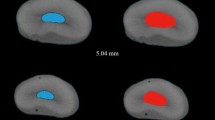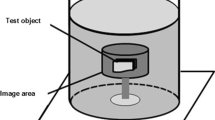Abstract
Objectives
To assess the effect of additional apical enlargement using nickel titanium (NiTi) instruments on the incidence of microcracks using micro-computed tomographic analysis.
Materials and methods
Fifty-one premolars with single canals were enlarged to ProTaper Gold (PTG) F2 (25/08) (Dentsply Sirona), ProFile Vortex Blue (VB) 25/06 (Dentsply Tulsa), or WaveOne Gold (WOG) primary (25/07) (Dentsply Sirona) NiTi rotary instruments (n = 17 each). Afterward, additional apical enlargement was performed in each group with its corresponding larger instrument (F3 (30/09), VB 30/06, or WOG Medium (35/06) instruments, respectively). All teeth were imaged with micro-computed tomography before canal enlargement and after initial and additional apical enlargements to detect new microcracks at the apical 5 mm. An Aligned Rank Transform ANOVA was conducted to examine the effects of file type and canal enlargement on the number of new microcracks resulting from enlargement. A Kruskal-Wallis test was run to compare the file types at each canal enlargement stage.
Results
A significant main effect (P = 0.026) of canal enlargement on the number of new microcracks was found; the number of apical microcracks found after additional enlargement was significantly greater than baseline (P = 0.021); no significant difference was found between baseline and initial enlargement (P = 0.506) and between initial enlargement and additional enlargement (P = 0.252). The Kruskal-Wallis tests found no difference between file types at baseline (P = 0.348), after initial enlargement (P = 0.369) or additional enlargement (P = 0.133).
Conclusions
Regardless of the instrumentation system used, additional apical enlargement led to the formation of high number of new microcracks.
Clinical significance
The results indicated that additional enlargement induced significant number of apical microcracks.

Similar content being viewed by others
References
Sathorn C, Palamara JE, Messer HH (2005) A comparison of the effects of two canal preparation techniques on root fracture susceptibility and fracture pattern. J Endod 31:283–287
Wilcox LR, Roskelley C, Sutton T (1997) The relationship of root canal enlargement to finger-spreader induced vertical root fracture. J Endod 23:533–534
Lang H, Korkmaz Y, Schneider K, Raab WH (2006) Impact of endodontic treatments on the rigidity of the root. J Dent Res 85:364–368
Nalla RK, Kinney JH, Ritchie RO (2003) On the fracture of human dentin: is it stress- or strain-controlled? J. Biomed. Mater. Res. 67:484–495
Adorno CG, Yoshioka T, Suda H (2009) The effect of root preparation technique and instrumentation length on the development of apical root cracks. J Endod 35:389–392
Adorno CG, Yoshioka T, Suda H (2011) Crack initiation on the apical root surface caused by three different nickel-titanium rotary files at different working lengths. J Endod 37:522–525
Ashwinkumar V, Krithikadatta J, Surendran S, Velmurugan N (2014) Effect of reciprocating file motion on microcrack formation in root canals: an SEM study. Int Endod J 47:622–627
Jamleh A, Komabayashi T, Ebihara A, Nassar M, Watanabe S, Yoshioka T, Miyara K, Suda H (2015) Root surface strain during canal shaping and its influence on apical microcrack development: a preliminary investigation. Int Endod J 48:1103–1111
Çapar ID, Uysal B, Ok E, Arslan H (2015) Effect of the size of the apical enlargement with rotary instruments, single-cone filling, post space preparation with drills, fiber post removal, and root canal filling removal on apical crack initiation and propagation. J Endod 41:253–256
Versiani MA, Souza E, De-Deus G (2015) Critical appraisal of studies on dentinal radicular microcracks in endodontics: methodological issues, contemporary concepts, and future perspectives. Endod Topics 33:87–156
Hilton TJ, Funkhouser E, Ferracane JL, Gilbert GH, Gordan VV, Bennett S, Bone J, Richardson PA, Malmstrom H, National Dental PBRN Collaborative Group (2020) Symptom changes and crack progression in untreated cracked teeth: one-year findings from the National Dental Practice-Based Research Network. J Dent. 93:103269
Toure B, Faye B, Kane AW, Lo CM, Niang B, Boucher Y (2011) Analysis of reasons for extraction of endodontically treated teeth: a prospective study. J Endod 37:1512–1515
Adorno C, Yoshioka T, Jindan P, Kobayashi C, Suda H (2013) The effect of endodontic procedures on apical crack initiation and propagation ex vivo. Int Endod J 46:763–768
Hieawy A, Haapasalo M, Zhou H, Wang ZJ, Shen Y (2015) Phase transformation behavior and resistance to bending and cyclic fatigue of ProTaper Gold and ProTaper Universal instruments. J Endod 41:1134–1138
Adıgüzel M, Çapar ID (2017) Comparison of cyclic fatigue resistance of WaveOne and WaveOne Gold small, primary, and large instruments. J Endod 43:623–627
Gao Y, Gutmann JL, Wilkinson K, Maxwell R, Ammon D (2012) Evaluation of the impact of raw materials on the fatigue and mechanical properties of ProFile Vortex rotary files. J Endod 38:398–401
Weiger R, Bartha T, Kalwitzki M, Löst C (2006) A clinical method to determine the optimal apical preparation size. Part I. Oral Surg Oral Med Oral Pathol Oral Radiol Endod 102:686–691
Rodrigues RCV, Zandi H, Kristoffersen AK, Enersen M, Mdala I, Ørstavik D, Rôças IN, Siqueira JF Jr (2017) Influence of the apical preparation size and the irrigant type on bacterial reduction in root canal-treated teeth with apical periodontitis. J Endod 43:1058–1063
Siqueira JF Jr, Perez AR, Marceliano-Alves MF et al (2018) What happens to unprepared root canal walls: a correlative analysis using micro-computed tomography and histology/ scanning electron microscopy. Int Endod J 51:501–508
Duque JA, Vivan RR, Duarte MAH, Alcalde MP, Cruz VM, Borges MMB, Bramante CM (2019) Effect of larger apical size on the quality of preparation in curved canals using reciprocating instruments with different heat thermal treatments. Int Endod J 52:1652–1659
Saini HR, Tewari S, Sangwan P, Duhan J, Gupta A (2012) Effect of different apical preparation sizes on outcome of primary endodontic treatment: a randomized controlled trial. J Endod 38:1309–1315
De-Deus G, Belladonna FG, Souza EM et al (2015) Microcomputed tomographic assessment on the effect of ProTaper next and twisted file adaptive systems on dentinal cracks. J Endod 41:1116–1119
Oliveira LRS, Braga SSL, Bicalho AA, Ribeiro MTH, Price RB, Soares CJ (2018) Molar cusp deformation evaluated by micro-CT and enamel crack formation to compare incremental and bulk-filling techniques. J Dent. 74:71–78
Jamleh A, Mansour A, Taqi D, Moussa H, Tamimi F (2020) Microcomputed tomography assessment of microcracks following temporary filling placement. Clin Oral Investig. 24:1387–1393
Jamleh A, Adorno CG, Ebihara A, Suda H (2016) Effect of nickel titanium file design on the root surface strain and apical microcracks. Aust Endod J 42:25–31
Arola D, Reprogel RK (2005) Effects of aging on the mechanical behavior of human dentin. Biomaterials 26:4051–4061
Kim H, Lee M, Yum J et al (2010) Potential relationship between design of nickel-titanium rotary instruments and vertical root fracture. J Endod 36:1195–1199
Huang CC, Chang YC, Chuang MC, Lin HJ, Tsai YL, Chang SH, Chen JC, Jeng JH (2014) Analysis of the width of vertical root fracture in endodontically treated teeth by 2 micro-computed tomography systems. J Endod 40:698–702
Bürklein S, Tsotsis P, Schäfer E (2013) Incidence of dentinal defects after root canal preparation: reciprocating versus rotary instrumentation. J Endod 39:501–504
Arslan H, Karataş E, Çapar ID, Ozsu D, Doganay E (2014) Effect of ProTaper Universal, Endoflare, Revo-S, HyFlex coronal flaring instruments, and Gates Glidden drills on crack formation. J Endod 40:1681–1683
Shemesh H, Lindtner T, Portoles CA, Zaslansky P (2018) Dehydration induces cracking in root dentin irrespective of instrumentation: a two-dimensional and three-dimensional study. J Endod 44:120–125
Lim H, Li FC, Friedman S, Kishen A (2016) Residual microstrain in root dentin after canal instrumentation measured with digital moire interferometry. J Endod 42:1397–1402
Kishen A, Rafique A (2006) Investigations on the dynamics of water in the macrostructural dentine. Biomed Res Int 11:054018
Hill MR, Panontin TL (1999) Effect of residual stress on brittle fracture testing. In: Panontin TL, Sheppard SD (eds) Fatigue and Fracture Mechanics. West Conshohocken, PA, ASTM International
Sprawls P (1995) Physical principles of medical imaging. Medical Physics Publishing, Madison, WI
PradeepKumar AR, Shemesh H, Chang JW et al (2017) Preexisting dentinal microcracks in nonendodontically treated teeth: an ex vivo micro-computed tomographic analysis. J Endod 43:896–900
Funding
This work was supported by a research grant (RC15/027/R) from King Abdullah International Medical Research Centre, National Guard Health Affairs, Riyadh, Kingdom of Saudi Arabia.
Author information
Authors and Affiliations
Corresponding author
Ethics declarations
Conflict of interest
The authors declare that they have no conflict of interest.
Ethical approval
This article does not contain any studies with human participants or animals performed by any of the authors
Informed consent
For this type of study, formal consent is not required
Additional information
Publisher’s note
Springer Nature remains neutral with regard to jurisdictional claims in published maps and institutional affiliations.
Rights and permissions
About this article
Cite this article
Jamleh, A., Nassar, M., Alfadley, A. et al. Influence of additional apical enlargement on microcrack formation in root dentine: a micro-computed tomography investigation. Clin Oral Invest 25, 4137–4143 (2021). https://doi.org/10.1007/s00784-020-03745-z
Received:
Accepted:
Published:
Issue Date:
DOI: https://doi.org/10.1007/s00784-020-03745-z




